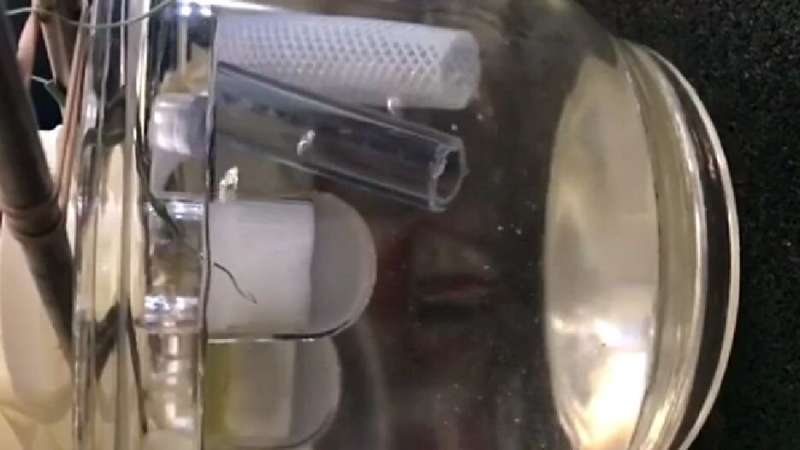'Snowball chamber' helps researchers use supercooled water to search for dark matter

After watching YouTube videos of people supercooling water in a bottle and then triggering it to freeze by banging it, something about this concept solidified for Matthew M. Szydagis, an assistant professor of physics at the University at Albany, State University at New York, especially when he saw it again during the Disney movie "Frozen."
During the 2019 American Physical Society April Meeting in Denver, Szydagis will describe how this inspired him to explore whether a subatomic particle like dark matter can trigger the freezing of supercooled water. Read more at https://arxiv.org/abs/1807.09253.
"All of my work is motivated by the search for dark matter, a form of matter we're sure is out there because we can observe its indirect gravitational effects," Szydagis said. "It makes up a significant fraction of the universe, but we have yet to uncover direct, conclusive and unambiguous evidence of it within the lab."
If water is clean enough—low in impurities, such as dust particulates—and placed in a smooth enough container, Szydagis explained, it can be cooled below its freezing point of 0 C (32 F) without freezing.
"This is called 'supercooling' and is similar to how water can be easily superheated in the microwave, essentially heated above its boiling point without actually boiling. It's simply the reverse," he said. "The water ends up, in either of these cases, in a state known as 'metastability,' neither unstable nor quite stable either."
A disturbance can trigger the phase transition, freezing and crystallization, in this case. "This isn't ordinary freezing, and it forms white snow instead of clear ice," he added. "We cooled liquid water to as cold as -20 C (-4 F). in our lab without it freezing. It isn't the same as freezing point depression, like when you salt your sidewalk, because the water was pure and not contaminated with impurities on purpose."
The group demonstrated that certain forms of particles hitting the water can microscopically (subatomically) cause it to freeze if it's supercooled first. "Some particles like neutrons can even scatter multiple times within the water," Szydagis said. "We were able to show this not only with commercially available sources of particles, but also a Fiestaware 'radioactive red' plate with orange uranium-based paint from the 1950s."
They created a new detector based on the supercooled water, dubbed the "snowball chamber" because that matches well with "bubble" and "cloud" chambers, which are technologies from the early- to mid-20th century that use boiling and condensation.
Supercooled water certainly isn't new; it's been studied for numerous decades by chemists and condensed matter physicists, down to -40 C (-40 F). There are even publications about it dating back more than 100 years old.
"But we managed to discover a new property of supercooled water," Szydagis said. "To our great surprise, we found that some particles (neutrons) but not others (gamma rays) trigger freezing. Since this is basic research that has never been done before, there was no guarantee it would work. It was a 'let's try it and see' approach—the scientific method in its most basic form. Not only do we have a new detector of fundamental particles, but potentially of dark matter because neutrons are thought to emulate it."
The group envisions numerous other potential implications for their discovery, including detecting nuclear weapons in cargo for homeland security, understanding cloud formation, and providing clues as to how certain mammalian species hibernate, supercooling their blood somehow.
More information: The presentation, "The Snowball Chamber: Using Supercooled Water to Search for Low-Mass Dark Matter," took place on Sunday, April 14, in room Governor's Square 11 at the Sheraton Denver Downtown Hotel. Abstract: meetings.aps.org/Meeting/APR19/Session/J09.8
Provided by American Physical Society





















